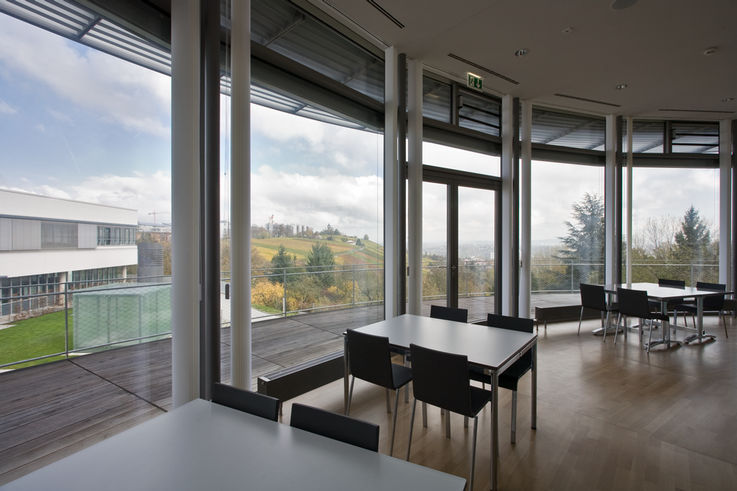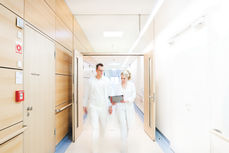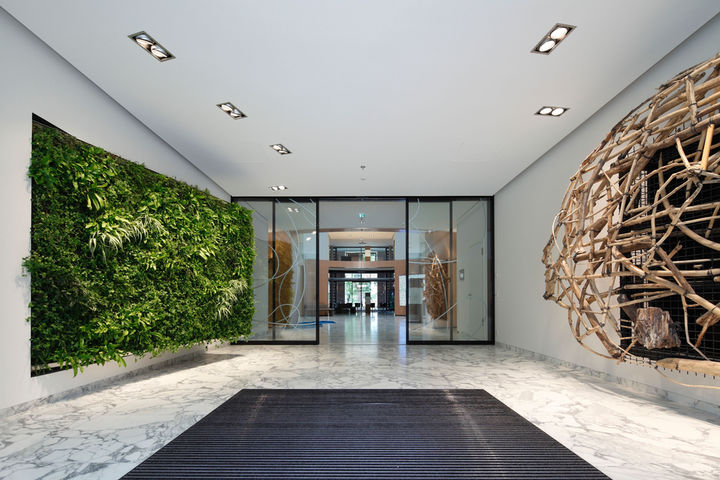Healing architecture – how building planning promotes well-being and healing
Hospitals, nursing institutions and retirement homes of course have to be clean, hygienic and even germ-free in some areas. They also need to comply with accessibility and fire protection regulations. This means the environment can often appear sterile, functional and not particularly welcoming. At the same time, such buildings need to constantly create an atmosphere which promotes the well-being and recovery of patients and residents, as well as staff and visitors. Combining these different needs makes building planning complex.
Hygiene regulations versus feel-good factor - incompatible requirements?

Robert Bosch Hospital, Stuttgart © GEZE
On one hand, there are hygiene regulations and measures considered vital in ensuring appropriate care for patients and visitors. On the other hand, the environment needs to be as comfortable as possible, but also ensure openness, security, safety and relaxation. Healing Architecture therefore deals with the connection between architecture and health on the basis of central questions: How can architecture contribute to healing? To what extent does a positive environment contribute to maintaining health? In addition to a lack of signposting, factors such as stress, noise, darkness and poor air have a negative effect on people’s well-being, and thus on their recovery. Good signposting, lighting and ventilation are thus crucial factors in achieving a positive result.
One building - experience space for different user groups
A hospital or care home is structured in a manner not unlike a small town. There are family rooms, intensive care wards, restaurants, supporting organisations, parks, and in many cases even a chapel. These many different areas must therefore be a positive experience for all user groups: for patients, residents and visitors alike. Care homes and retirement homes are also workplaces for many skilled workers – and the well-being of the staff has an immediate effect on patients and residents.

What is Healing Architecture?
The term ‘healing architecture’ was first coined in the 1980s, and is a specific discipline of the ‘healing environment’, which investigates the influence of the environment on patients’ healing and recovery process. It originates from a study published in 1984 by Roger Ulrich, Professor of Architecture at the Centre for Health Design in Sweden. He showed that patients could be discharged earlier, and needed fewer painkillers post-surgery, if they were in rooms with a view of a park with trees. Later studies demonstrated which other factors are important not only for the well-being of patients and residents, but for employees as well.
GEZE supports important goals of Healing Architecture
‘Healing architecture’ is all about helping patients and residents in the process of self-healing and recovery. To promote healing and well-being, the aims of healing architecture include the following:
- Prevent environmental stresses such as noise, e.g., from slamming room doors, a lack of private areas and barriers. GEZE offers numerous products and solutions in the area of automatic door systems for barrier-free access to buildings and door damping. Modular partition wall systems can also provide more privacy without losing sight of the design aspect.
- Patients and residents should be as close to nature as possible, for example by means of outdoor views, sufficient sunlight and fresh air. Our natural ventilation concepts and our solutions for glass façades are in demand for this.
- Patients and residents should also retain a feeling of control by being offered opportunities to access outside spaces, for instance. Our products for accessible sliding doors and access control opportunities are paramount in this regard.
Enter rooms contactlessly thanks to automatic doors

Floor infront the operating rooms at Children's Memorial Health © H. Łukasz Janicki / GEZE Polska
Accessibility, retreat options and views play a major role in hospital architecture, for example. However, daylight and a supply of fresh air also have a significant influence on building planning. Modern architecture thus focuses on actively using these free forms of therapy – and installing large window fronts or fanlights, for example.
The topic of natural ventilation is also of central importance. door and window solutions to be fully integrated into building planning. Automatic doors guarantee universal and non-contact access, resulting in a high level of hygiene – whether in passages, lounge areas or operating theatres. Window drives, in combination with a building automation system, create automated ventilation which also ensures a non-contact and comfortable ambient climate. Automated doors and windows thus comply with fire protection and RWA solution demands, while also supporting the concept of healing architecture.
Better compliance with hospital hygiene - thanks to GEZE door and window systems

TSA 160 NT Operating room with hermetically sealing doors © H. Łukasz Janicki / GEZE Polska
To ensure that the Healing Architecture concept can be successfully implemented, we offer numerous components and functions that contribute to hospital hygiene, accessibility and non-contact operation of windows and doors. It could be to protect the recuperation process for patients, for example by means of the consistent contactless, and therefore germ-free, usage of doors and windows. Another example would be measures which are conducive to healing, health and well-being, such as the supply of fresh air. We have already equipped numerous nursing institutions and health care facilities with our door and window solutions.
Products developed specifically for sensitive areas in hospitals, such as our modular, hermetically closing GEZE MCRdrive sliding door system, round off the portfolio.
The entire health care sector is changing: not only retirement homes, but every clinic should no longer feel like a hospital for patients, employees and visitors, but rather inviting and comfortable. Our task here is to actively help shape this changing process with our solutions and products.
Karen Sum, Head of Global Account ManagementHolistic building planning with all stakeholders as a success factor

Fanlights and all-glass systems create a friendly atmosphere in the waiting room. © GEZE
Uniting the needs of different user groups such as patients, employees, as well as operators etc. is a real balancing act, involving various parties from the different trades involved with implementation. Our integrated approach and the cross-sector usage of our products is a major advantage in the sensitive field of health care. Be it accessibility for patients or residents, convenience and security for care staff or protected and germ-free access to clean room areas – our range of products and solutions meet many of these requirements.
The "healing architecture" begins with the experiences of the users - and the opportunities for improvement they have gathered. All the users of a building thus need to provide their input and feedback to make healing architecture a success in health care institutions – and also ensure the operator’s financial success. What is important here is holistic building planning with all trades right at the start of the project - we are happy to support you with our expertise in the area of BIM.
Find out more about BIM office buildings
User-orientated and economical - GEZE solutions in the health care sector
Not only does this approach increases employee efficiency, it often also reduces patients’ length of stay. The latest examples have demonstrated how well-thought out architecture and design concentrated on promoting healing can have measurable effects on the recovery of patients, including shorter hospital stays, fewer hospital infections and less pain. Overall, these measures can improve the financial performance of hospitals and nursing institutions.
Our package solutions in the health care sector

Children's Memorial Health Institute, Warsaw © H. Łukasz Janicki / GEZE Polska
Be it noise reduction, empowering vulnerable users, maintaining hygiene, discreet safety measures or natural ventilation – GEZE understands the fundamental features of an efficient facility with an atmosphere of well-being. The combined, cross-trade use of our products results in customised packages for health care facilities - from entrance areas to passages, lounges and waiting rooms, operating theatres, laboratories and administrative areas. These packages respond to the familiar challenges with a preconfigured set of system solutions that maximise your benefits - and can of course also be seamlessly integrated into your building automation system via myGEZE Control.
Our special GEZE package solutions in detail
We are of course happy to adjust our offer to meet your specific demands, customising the packages described below entirely to meet your needs. We can also create totally tailored solutions. We very much hope to support you.
Package 1 – specifically for entrance areas

This package focusses on door and window solutions for the entrance area of your building. The design of the reception area has a direct influence on how comfortable patients, residents and visitors feel. This package therefore focuses on door and window solutions for the entrance area of your building.

TSA 325 NT © Martin Jakob / GEZE GmbH
Automatic revolving door system for maximum convenience with a high access frequency – internal diameter of up to 3600 mm.
High performance: reliable even during intensive usage, e.g., in entrance areas

GEZE Powerturn
The Powerturn automatic swing door drive can open large heavy doors reliably and safely. This swing door drive fits perfectly with every design, thanks to its low overall height of just 7 cm.
Noise reduction: silent operation, acoustic insulation, e.g., given intensive usage in entrance areas or passages
Reduced stress, increased safety: free passage without obstructions, constant and quiet transport without abrupt stops, e.g., when transporting patients

myGEZE Control © GEZE GmbH
With myGEZE Control, we are closing the gap in building automation with a smart solution for networking door, window and safety systems. The connectivity platform myGEZE Control with modular software and open interfaces opens up completely new ways of building automation for all planners and building operators.
- For more efficiency, safety, and convenience
- For dynamic safety and fire protection concepts, intelligent smoke and heat extraction, and the targeted release of escape routes
- For more networking options

GEZE ActiveStop © GEZE GmbH
The GEZE ActiveStop door damper enables gentle stopping, quiet closing and convenient hold-opening.
Noise reduction: silent operation, acoustic insulation, e.g., given intensive usage in entrance areas or passages

GEZE Slimchain © GEZE GmbH
Chain drive in an attractive design for inwards and outward-opening windows, optimally integrated into the façade design, thanks to its narrow and discreet appearance.
Combined usage: can be used for almost all rooms, for higher air quality and cutting energy costs by means of natural ventilation
Self-determination: Autonomous control of the patient's fresh air supply without having to leave the bed

GEZE offers special solutions for health care facilities - for both indoor and outdoor use.
Package 2 – specifically for interior and outer areas
This package contains different solutions for a wide range of uses in interior and outer areas areas of your health care facility. As a rule, a large number of users of a building also place very different demands on the building. This package therefore includes various solutions for a wide range of indoor and outer area applications in your health care facility.

GEZE Slimdrive © Martin Jakob / GEZE GmbH
Glass façades with maximum design demands.
Improved hygiene: non-contact entry and exit of rooms or crossing of passages; efficient cleaning via the ‘Cleaning’ mode, which prevents the door from moving
Reduced stress, increased safety: free passage without obstructions, constant and quiet transport without abrupt stops, e.g., when transporting patients

myGEZE Control © GEZE GmbH
With myGEZE Control , we are closing the gap in building automation with a smart solution for networking door, window and security systems. The connectivity platform myGEZE Control with modular software and open interfaces opens up completely new ways of building automation for all planners and building operators.
- For more efficiency, safety, and convenience
- For dynamic safety and fire protection concepts, intelligent smoke and heat extraction, and the targeted release of escape routes
- For more networking options

GEZE Pendulo system © GEZE GmbH
The Pendulo all-glass wall system offers a wide variety of elegant solutions.
Feel good factor: the means of choosing open and transparent rooms or a view of the outdoors

GEZE E 1500 N © Nikolaus Grünwald / GEZE GmbH
The spindle drive with narrow dimensions is particularly suitable for heavy leaves in façades and roof areas with maximum design demands.
Combined usage: can be used for almost all rooms, for higher air quality and cutting energy costs by means of natural ventilation

Package 3 - especially for the sensitive internal areas of a hospital
The package includes solutions for the most sensitive areas of the hospital. Maximum hygiene and functional safety are the top priorities here. Solutions specifically customised to the application ensure smooth operation. For the benefit of patients.

GEZE MCRdrive © GEZE GmbH
GEZE MCRdrive is a modular sliding door system for building areas with hermetic airtightness requirements. The sliding door system was specially designed for use in access areas of operating theatres, quarantine rooms and intensive care areas in the health care sector, in laboratories at research institutes and in the pharmaceutical and food industries.
What makes it special: GEZE MCRdrive offers functional product safety through a standard conform and certified overall system and fulfils the requirements of building projects with modern and appealing design concepts. GEZE MCRdrive also offers configuration options for maximum customer customisation, thanks to its modular design and standardised profile and sealing system.

RFID readers are used in access control systems. © GEZE GmbH

Public traffic in a building can be easily controlled via RFID reader. © GEZE GmbH
RFID readers are used in access control systems to control public access to your building. A simple solution is the use of ID cards or PIN codes. The I/O box takes over the door control and monitoring. Modern RFID readers read the access authorisations and fit seamlessly into the design of your swing or sliding door systems.
Functions:
- Read-out of access authorisations
- Encrypted data communication with the door control unit
- Optical and acoustic signalling
- PIN keypad for authorisation assignment using a master card
- High-quality glass look
Use:
- Inner and outer area (IP54)
- Non-secured outer area

The non-contact proximity switch GC 307+ from GEZE. © GEZE GmbH
Automatic doors can be conveniently controlled and opened with the non-contact proximity switch.
- External input for LED colour switching
- Detects persons and objects in a detection area of 10 - 60 cm
- Scanning ranges adjustable to make environmentally and user-specific adjustments
- Installation height at hand level ensures convenient, barrier-free access
- Can also be installed behind tiles or glass

ECdrive H offers optimised opening widths for hospital operation (nurse, cleaning and bed opening).
The automatic linear sliding door system for areas with increased hygiene requirements offers a wide range of options for project-specific collaboration with manufacturers:
- Consists of a drive kit and aluminium profiles
- Special track reduces dirt residue and simplifies hygienic cleaning
- Optimised opening widths for hospital operation (nurse opening, cleaning opening, bed opening)
- Can be networked, and integrated into the building automation via open standard (BACnet)
- Independent error recognition and recording
The benefits of our products in a nutshell
- Combined benefits: higher air quality and energy cost savings, thanks to door and window concepts for natural ventilation
- Noise reduction: noiseless door drive and damping technology as well as automated acoustic insulation to minimise noise
- Improved hygiene: non-contact entering and exiting of rooms
- Accessibility: easy access for people with reduced mobility, thanks to automatic door systems
- Saving energy costs: intelligent climate control concept through controlled control of doors and windows, depending on the temperature and frequency of use
- Maximum safety: reliable smoke and heat extraction through appropriate concepts and systems



